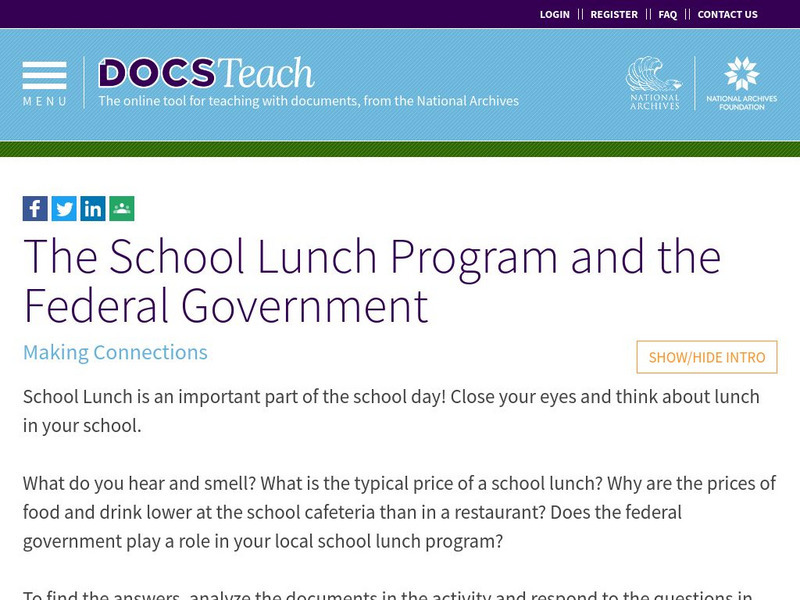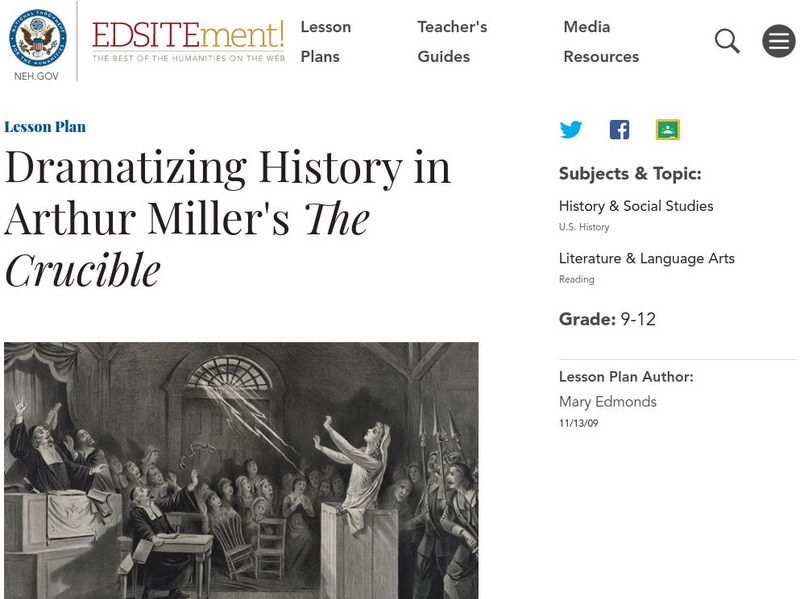US National Archives
Nara: Teaching With Documents: Message From Eisenhower to Marshall
This lesson takes a close look at a primary document written by General Eisenhower to General Marshall. The document reflects a lack of information about the invasion that was underway. There are activities and worksheets included.
US National Archives
Nara: Teaching With Documents: The Amistad Case
The National Archives and Records Administration (NARA) provides background information for the Amistad case, several of the actual documents involved in the case, and teaching activities that correlate the information (at the bottom of...
US National Archives
Nara: Teaching With Documents: Photographs of the 369th Infantry
Background information on the African American troops in the 369th Infantry accompanied by teaching activities that allows young scholars to analyze photographs and use the information in many curricular connections.
US National Archives
Nara: Teaching With Documents: Little House in Census: Almanzo and Laura Wilder
Data from the 1880 and the 1900 Censuses, and how these relate to the lives of Almanzo and Laura Ingalls Wilder, are presented here. There are also ideas for teaching using primary sources.
US National Archives
Nara: Teaching With Documents: The Zimmerman Telegram
This is an excellent resource for anyone intersted in the Zimmermann Telegram: click to see the original coded message, the decoded message, and read about the implications of the telegram. This National Archives and Records...
US National Archives
Nara: Teaching With Documents: Petition of Amelia Bloomer Regarding Suffrage
Amelia Bloomer was a prominent advocate of women's rights in the 19th century. She invented bloomers to replace the skirt hoop, in an effort to free women from much of their cumbersome apparel. She later used her newspaper, The Lily, to...
US National Archives
Nara: Teaching With Documents: Black Soldiers in the Civil War
This comprehensive site from the National Archives and Records Administration (NARA) describes the history of the participation of colored troops in the Civil War and government efforts to research and compile records about them....
US National Archives
Nara: Teaching With Documents: The United States Enters the Korean Conflict
This is a lesson plan outline which correlates the relationship between NSC-68 and U.S. policy in Korea. A National Archives and Records Administration site (NARA) with additional links to more teaching resources.
US National Archives
Nara: Teaching With Documents: An Act of Courage: Arrest Records of Rosa Parks
A vividly detailed account of the events that led to the arrest of Rosa Parks for "violating a city law requiring racial segregation of public buses". Provided are copies of documents relating to her arrest that were used as evidence in...
US National Archives
Nara: Teaching With Documents: Eli Whitney's Patent for the Cotton Gin
This National Archives and Records Administration site relates the history of Eli Whitney and his remarkable inventions. Links to sites with patent information on the cotton gin. Tons of teacher's resources can be found at this site.
Other
Library of Congress: Teaching With Primary Sources
This website is an excellent resource for teaching with primary sources. This resource features Holocaust lessons, lesson plan strategies, and podcasts.
US National Archives
Nara: Teaching With Documents: Beyond the Playing Field: Jackie Robinson
The National Archives and Records Administration (NARA) provides several primary source documents pertaining to Jackie Robinson's period of civil rights advocacy, as well as corresponding lesson plans.
US National Archives
Nara: Teaching With Documents: Anti Railroad Propaganda Poster
From the National Archives and Records Administration site, this lesson, focusing on a poster circulated in Philadelphia in 1839 to discourage the coming of the railroad, relates to the struggle to define the powers of the national and...
US National Archives
National Archives: Teaching Six Big Ideas in the Constitution
The Constitution can be broken down into 6 main themes: Limited Government, Federalism, Republicanism, Separation of Powers, Checks and Balances, and Popular Sovereignty. Learners will study background on the Founding Fathers and use...
Teaching American History
Teaching American History: Bill of Rights
Enrich learning about the U.S. Constitution's Bill of Rights with the help of this comprehensive resource. Find details about the amendments added to the new national document.
Daily Teaching Tools
Daily Teaching Tools: How to Teach Spelling
A teaching resource with free downloads of PDF documents and graphic organizers along with guidelines and practice activities to use while teaching students to become better spellers.
US National Archives
Docsteach: The School Lunch Program and the Federal Government
Learners will draw upon the visual and textual data presented in photographs and documents to gain an understanding of how the federal school lunch program is a direct result of the Great Depression, how it became a permanent part of the...
ReadWriteThink
Read Write Think: Writing Poetry With Rebus and Rhyme
An excellent resource for teachers who are interested in teaching innovative poetry techniques to their elementary students. Uses proven and well-documented methods to teach poetic elements in reading and writing.
Better Lesson
Better Lesson: Think About Adding Nothing and a Little More
Lay the foundation for addition facts with introducing students to "the understanding that the number relationships between 0 more than, 1 more than, and 2 more". To help implement this lesson the website contains documents and videos.
Library of Congress
Loc: Teachers: Personal Stories and Primary Sources
Students will explore the value of personal stories and first-hand accounts when exploring history, in this case, the events of the early twentieth century, which included World War I and the Great Depression. Through this five-unit...
Internet History Sourcebooks Project
Fordham University: Medieval Sourcebook: History Through Primary Sources
This site from the Medieval Sourcebook answers the question: Why Study History Through Primary Sources? It provides complete information, a list of review questions, and bibliography information.
National Endowment for the Humanities
Neh: Edsit Ement: Dramatizing History in Arthur Miller's "The Crucible"
Critical analysis of both the historical documents and the literary texts connected with the Salem trials is key to this lesson, which includes a number of activities and some wonderful resources.
University of California
Regents of the University of California: Using the Cognates Strategy
This strategy guide introduces an approach for making students aware of cognates (words that have a similar spelling, pronunciation, and meaning across languages) in content-area texts. This guide includes an introductory section about...
University of California
Cal Heritage Collection: Using Primary Sources
This resource covers what primary sources are, where we can find them, and how we can assess them in the classroom.








